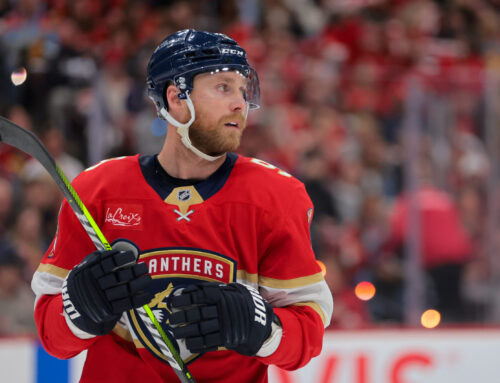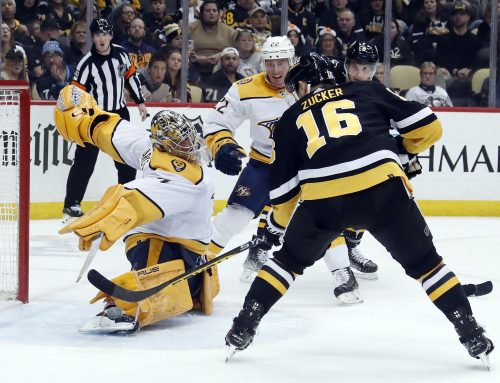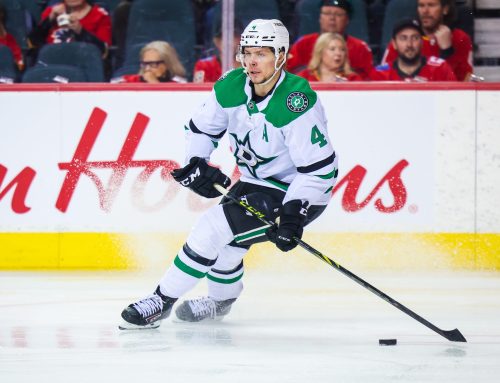
This week's Capped discusses how NHL teams allocate their salary cap, and what lessons we can take for your fantasy team.
****
Welcome back readers to another Thursday filled with number crunching. Hopefully you can all follow along through those post-Halloween sugar comas! Fantasy hockey numbers can be tough to wrap your head around on the best of days, and on the worst days it starts to look like University calculus. Sometimes, figuring out how best to fit a fantasy team under the salary cap can feel like a full time job. In the NHL, there are actually people who have that task as a full time job! With the recent hiring of Tom Poraszka, the founder of General Fanager, the new Las Vegas organization has shown that they are fully invested in the idea. So, by looking around the NHL, is there a way that we can learn a few things from the pros? In terms of allocating cap money for stars vs. rookies, and from forwards to defence to goalies, there likely isn’t one right answer, but is there a consensus among NHL teams?
The salary cap was implemented over 10 years ago, and teams are still tinkering with how best to manage it. Teams like the Chicago Blackhawks seem to have to trade out at least one star player every off-season in order to ensure they are salary cap compliant. Contrarily, teams like the Arizona Coyotes have to have to pay players to not play for them in order to make the numbers fit. There are many factors that cause these differences from team to team. In order for our analysis to be as consistent as possible, there will have to be a few guidelines in place; salary cap extras, such as buy-outs, retained salary, and recapture penalties will be excluded. Player salaries for this season will be used, however it is important to note that Jacob Trouba is still unsigned in Winnipeg**, and injuries have caused slight discrepancies in salaries.
Salaries were taken on Saturday October 29th, so there may be a small difference or two by now due to certain roster moves. The most noticeable of the discrepancies though is with the goalies. This is due to the fact that three teams over the last week have had to roster four goalies. Boston, Los Angeles and Ottawa have all lost their top two goalies for various stretches of time, and had to call up both of their AHL net-minders*. This added on a little under $2 Million to all three teams, which may not seem to be a huge amount in the context of a $73 Million dollar salary cap, but with the average team paying over $6.5 Million on goalies, it makes a difference. Let’s take a look.

Staying with the goalie theme, there are a few things that stick out right away. The first aspect to consider is the tiny amount that the Winnipeg Jets are paying for their goaltending that has allowed 28 goals in their first 10 games. That is a respectable number in comparison to the miniscule salary. Winnipeg is running with their rookie goalie Connor Hellebuyck, and the entry-level contract is what allows them to spend so little on goaltending. There are a few other teams such as Buffalo, San Jose, Calgary that are spending $3 Million or less on their starting goalie, with varying amounts of success. Goaltending is such an unpredictable position, that it is worth paying a bit of a premium for the certainty that some of the stars bring to the table.
Strangely enough, the Dallas Stars, winners of the Western conference in 2015-16, take another approach. Their bottom forwards and defence are so cheap, that they can use some extra money on goalies. With the highest money spent by either team, you would think they would be getting more than league average goaltending. However, it’s quite the contrary, as last year they had a save percentage of 0.906%, compared to the league average of 0.915%. Over the course of an 82 game season, that is a big deal. If their two goalies Antti Niemi and Kari Lehtonen can’t improve for this coming season, then the Stars are going to find it hard to repeat last seasons’ success.
On their own, goalies can do quite a lot, but they can’t do everything. In the past, good team defence has sometimes been able to cover up sub-par goaltending. However there are also some interesting trends with the defence. Calgary is the team paying the most for their defence (and the only team over $30 Million), but they also have Brian Elliott in net, who has posted some of the best save percentage numbers over the last few season. Unfortunately, Calgary is last in the league in goals against, having allowed 40 already this season. Arizona is the team with the next highest paid defence core, but they are last in the league in goals against per game, and only Calgary has more goals against on the season. On the flip side of defensive efficiency, both Arizona and Calgary are in the top third of the league for points by defenceman (23 and 24 points respectively). Carolina and New Jersey, the two teams with the lowest paid defence cores, have 20 and 13 points respectively. So it seems that there is more of a relation to the offence than the defence, when it comes to paying NHL defencemen.
Moving on to the forwards, Arizona sticks out like a sore thumb, because they are paying less than half of what Pittsburgh and St. Louis are paying their forward groups. This is due to their internal cap limits, and the fact they have so many rookies in their forward ranks. Other than Arizona however, no single team seems to stand out in terms of salaries. Carolina has the next lowest total, but they are also one of the teams with the smallest budgets, so it is expected. Overall, it seems that with the depth of forwards on teams, the ones such as Pittsburgh that are top heavy with salaries, also balance it out with more entry level contracts for the bottom forwards. Contrarily, the teams without the expensive forwards at the top of their lineups are able to spend a little more to fill out the bottom half of the forward group.
How does this then get applied to fantasy hockey though? First, a few more numbers are necessary. Knowing your league setup is very important here, whether there is one goalie slot or two, and what the ratio of forward to defence slots are. For example, my bigger cap league is a roster of 12 forwards, six defence, and two goalies, with five bench spots rounding out the 25. Ignoring the bench spots, it is the same size as an NHL lineup. The first thing to note though is that we have only 12 teams, so there is a much greater saturation of talent, and thus salaries. As such, the salary cap in this league hovers $25 Million above that of the NHL any given year.
Looking at a league such as this, the first thing to notice is that in comparison to the NHL there are less than half the teams, but the same number of goaltenders to choose from. Therefore, in order to compete, at least two NHL goalies are necessary, and it is unlikely that two cheap options can be found to match the 10% that an average NHL team would spend. If possible, all the better; but more likely, it will be in the 15% range, as all of the high paid NHL starting goalies will be rostered. The price on goaltending really depends on the strategy that is being employed, but as with the NHL, the price is worth the known consistency in net, as it is much easier to find bargains at other positions.
The 5% of the salary allotment that was moved to goaltending has to be taken away from somewhere. Is defence then the best spot to take it from? Past the small top tier of fantasy defencemen such as Erik Karlsson and Brent Burns, there is a real drop off in terms of relevance and production. Defence can provide much less expensive value in leagues that count stats such as hits, blocks and penalty minutes, because defence rack them up at much greater rates. They also generally provide less offence to begin with, so there is less of a drop off from the mid-tier players to the lower ones than there are with forwards.
Or at least you would think that would be the case. Last season, the drop in points from the 50th ranked defenceman, to the 100th to the 150th, was from 30 points down to 17, and then down to 10. This gives differences of 13 points and then 10. With the forwards from 50th to 100th to 150th, the differences were eerily similar. Both of these sets on numbers show that the drop off isn’t too big from the middle tier to the bottom tier of defencemen or forwards. But when the number of actual rostered players is taken into account, we see that forwards do drop off a little more when getting down to the bottom of the list.
We can put aside the top few highly paid options on defence. They will be worth the investment. Players such as Karlsson, Burns, Dustin Byfuglien and Kris Letang are worth owning; end of story. Getting down to the bottom half of the defence though, there is not much tail off between the middle tier, and what would be the more cost effective lower tier. If possible, it makes sense to take those couple extra million from the back end of a defence core, in order to make sure that your goalies are as solid as possible.
Looking solely at the forwards, the NHL wide average of 58% is interesting to dive deeper into. Twelve of the fifteen highest paid players in the league are forwards, but then again, the bottom lines are generally filled out with entry-level contracts and bargain signings from late that summer. This causes the large range in actual money paid, from the $45 Million that St. Louis and Pittsburgh dole out to their star talent, to the $22 Million that Arizona pays their relatively unproven forward ranks. The tough thing is finding a correlation between the actual salaries of each position, and the number of points that a team accumulates over a season. There is a positive correlation between spending more overall, but there isn’t much of a deviation based towards one position or another.
Another way to look at it is to see if the top teams in the NHL are more top heavy with their contracts, or more spread out. Based on the recent success of Dallas, Pittsburgh, San Jose, Washington and Chicago, there is certainly a very good case to be made for paying the price to roster star talent, and then filling in around those players. The Chicago model especially seems to be having success, and it has been well profiled. Solid goaltending, two stud defencemen, a top set of forwards, and then filler players around it. Trying to name third line players from the Chicago Stanley cup wins in 2013 and 2015 is actually difficult to do off the top of your head.
So what can we learn from this? Well it is very difficult to win when a certain position is punted. In general, the teams that are skimping on a position are the ones that did not make the playoffs last year (Forwards: Arizona, Calgary, Montreal / Defence: New Jersey, Carolina / Goalie: Winnipeg, Buffalo, Calgary). The biggest conclusion to draw is that depth across all positions is needed in order to compete, however depth in a certain position is better off being forsaken for a top-heavy approach.
I would be curious to hear about stories, experiences, thoughts and lessons that you have all learned in terms of best setting up a salary cap team. There is no single perfect strategy, which makes it so much fun. Hopefully this can, at minimum, help build the backbone of a strategy for how to approach constructing a salary cap team.
Thanks again for tuning in. Until next time! And try not to eat too much candy.
One Comment
Leave A Comment
You must be logged in to post a comment.





 MTL
MTL
 PIT
PIT FLA
FLA S.J
S.J MIN
MIN CGY
CGY L.A
L.A VGK
VGK

I might start sounding like a broken record, but here’s my experience/expertise in setting up a salary cap team for a points only league.
1. Set a baseline, expected return for a $1M player. This will be different for F, D and G.
2. Set an expected return on each $1M invested after that. This will be the same for F, D, and G.
3. Score players based on how you expect them to perform compared to the return you would expect from their salary.
Then you can basically rank players by ‘value’ and you are off to the races (and a championship).
My settings prior to this year’s draft were:
$1M Forward: 48 points
$1M Defence: 30 points
$1M Goalie: 58 points (2 points for a win, 1 point for OTL, 1 point for SO, 1 point for assist/goal)
After that I set the return on $1M at 4 points.
My league is 9F, 4D, 2G active roster. $73M cap.
(9×48) + (4×30) + (2×58) + ((73-15)x4) = 900 points.